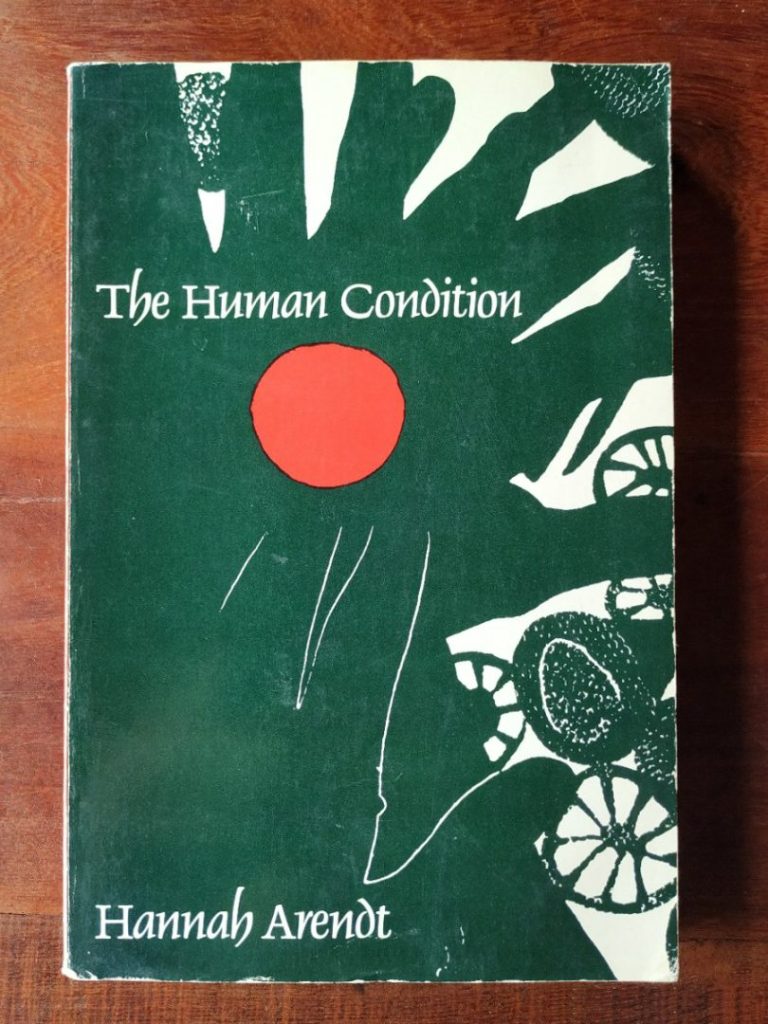
Table of Contents
Buy as E-book, Paperback, or Hard-cover
Understanding the Vita Activa
Published in 1958, Hannah Arendt’s The Human Condition is a cornerstone of modern political philosophy. In it, Arendt analyzes the active life (vita activa) of human beings, dissecting it into labor, work, and action. She does not offer a political program but a philosophical anthropology—a deep inquiry into what it means to live as a human in the public realm. At once classical and radical, this book redefines how we understand politics, freedom, and the human experience.
In a postwar world struggling to make sense of technological advancement, totalitarianism, and the loss of public meaning, Arendt’s insights remain startlingly prescient. Her book asks: What does it mean to be human in a world where the boundaries between public and private, natural and artificial, have blurred?
Labor, Work, and Action: The Three Modalities
At the core of The Human Condition lies Arendt’s tripartite analysis of human activity:
- Labor refers to our biological processes and necessities—what is cyclical, unending, and tied to survival. It is the activity of the body.
- Work represents the human ability to create lasting artifacts—tools, institutions, and infrastructure. It is world-building, giving us relative permanence.
- Action, the most distinctively human activity, involves speech and deed in the public realm. It is unpredictable, spontaneous, and bound to plurality and freedom.
Unlike many modern thinkers, Arendt does not collapse human experience into one economic or biological function. Instead, she insists on the irreducibility of each category, especially of action, which she sees as the highest realization of human freedom.
The Rise of the Social: A Crisis in Distinction
One of Arendt’s key arguments is that modernity has confused the public and private realms, ushering in what she calls the “rise of the social.” In classical thought, the private domain was for necessity (labor), while the public sphere was the domain of freedom (action). Modern society, however, has rendered all domains socialized and managed—politics becomes administration, action becomes behavior.
This shift erodes true public freedom. With economic necessity overtaking the political realm, Arendt claims we lose the space where newness and plurality—two key human capacities—can emerge.
Her critique anticipates many later concerns about bureaucracy, mass society, and the disappearance of authentic public discourse.
The Space of Appearance and the Political Life
A crucial idea in Arendt’s philosophy is the “space of appearance,” a metaphor for the public sphere where individuals disclose their identities through word and deed. This space is not defined by physical location but by the presence of others. Action only becomes meaningful when it is witnessed and responded to.
Politics, in Arendt’s view, is not about control or governance—it is about participation and mutual recognition. It is in action, not production or contemplation, that human beings reveal who they are, not merely what they are.
In contrast to modern technocratic governance, Arendt’s vision of politics is agonistic and narrative: it is shaped by storytelling, debate, and the shared risk of beginnings.
Technology, Automation, and the Loss of World
Though The Human Condition is not a treatise on technology, Arendt devotes a prescient section to the threat of instrumental reason. As humanity shifts from labor to automation, and from craftsmanship to mass production, we risk losing our connection to the world—a realm of durable objects and shared meaning.
She warns that technology’s promise to eliminate labor might paradoxically deprive us of the conditions necessary for action and remembrance. The human world, as a shared and stable realm, gives us identity and legacy. If we lose this, we also lose the space in which freedom becomes possible.
Strengths and Contemporary Relevance
Strengths:
- Offers a rich, multidimensional theory of human activity
- Profound analysis of the decline of political life and public freedom
- Accessible yet deep critique of modernity, still resonant today
Relevance Today:
- The rise of surveillance capitalism and social media echoes Arendt’s fear of the social overtaking the political
- The erosion of public discourse aligns with her concerns about the loss of the space of appearance
- The automation of labor and the commodification of work echo her critiques of mass society and instrumentalism
Her ideas remain indispensable for anyone questioning how we live together in the age of digital platforms, AI, and global crisis.
Who Should Read It?
- Students of political theory and philosophy
- Readers concerned with the meaning of civic life in contemporary society
- Feminist scholars (despite Arendt’s own complex relationship to feminism)
- Anyone seeking a deeper framework to evaluate the political and technological shifts of the 21st century
Limitations and Critique
Arendt’s work is sometimes criticized for its Eurocentrism and abstraction. She largely ignores economic exploitation, race, and gender as categories of analysis. Though she revalorizes the political, her idealized vision of the polis can seem elitist or detached from material struggle.
Still, these limitations do not diminish the value of her insights—they invite augmentation. Arendt’s categories can be retooled, not discarded, in contemporary critique.
TL;DR
The Human Condition is a profound rethinking of what it means to live as a human being among others. Arendt’s rejection of reductionism—whether biological, economic, or technological—offers a blueprint for defending freedom and plurality in a homogenizing world.
Her call is not nostalgic but revolutionary: to reclaim public life, not through domination or ideology, but through speech, action, and shared responsibility. In an era when we are more interconnected than ever but increasingly depoliticized, Arendt challenges us to reimagine what it means to appear, to speak, and to act as humans.
Leave a Reply